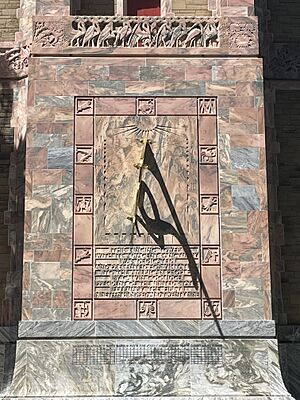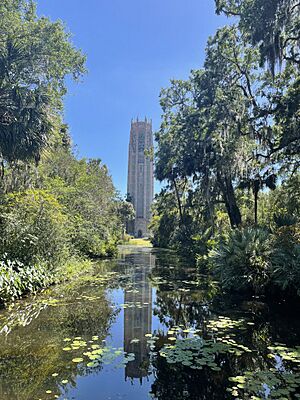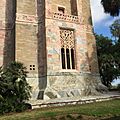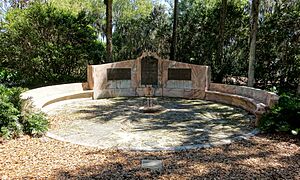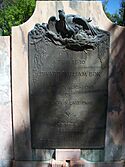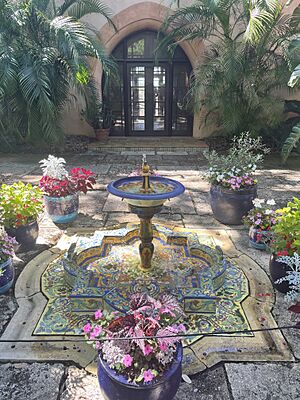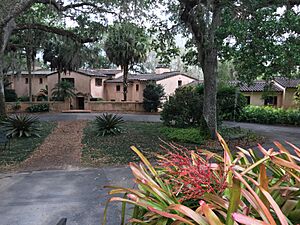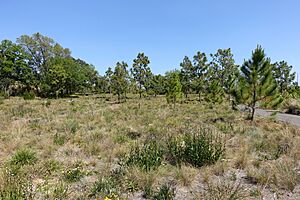Bok Tower Gardens facts for kids
|
Bok Mountain Lake Sanctuary and Singing Tower
|
|
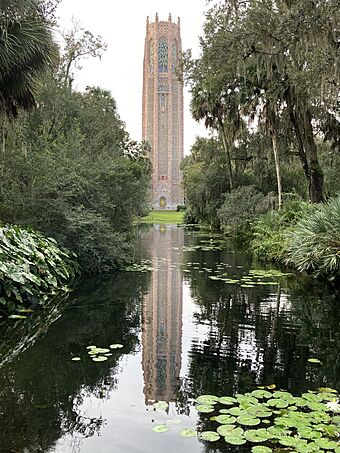
North facade of Singing Tower
|
|
| Location | Iron Mountain |
|---|---|
| Nearest city | Lake Wales, Florida, United States |
| Built | 1924–1928 (gardens) 1927–1929 (tower) |
| Architect | Frederick Law Olmsted Jr. (gardens) Milton B. Medary (tower) |
| Architectural style | Gothic Revival, with Art Deco detailing |
| NRHP reference No. | 72000350 |
Quick facts for kids Significant dates |
|
| Added to NRHP | 21 August 1972 |
| Designated NHL | April 19, 1993 |
Bok Tower Gardens is a beautiful place in Florida with 250 acres of gardens and a special home for birds. It sits on top of Iron Mountain, near Lake Wales, Florida. Edward Bok created this amazing spot in the 1920s.
This special place used to be called the Bok Mountain Lake Sanctuary and Singing Tower. Today, you can explore the famous Singing Tower, which has 60 bells that play music. Other cool spots include the Bok Exedra, the Pinewood Estate (also known as El Retiro), the Pine Ridge Trail, and the Visitor Center.
Bok Tower Gardens is so important that it's a National Historic Landmark. The Singing Tower is 205 feet tall and stands on one of the highest spots in Florida, about 295 feet above sea level. It's also listed on the National Register of Historic Places. The gardens and tower are famous because of Edward W. Bok and the talented people who helped him design them. The Pinewood Estate next door is also a historic site.
You can visit Bok Tower Gardens any day, but there is a small fee to enter.
Contents
Exploring the Gardens
Edward William Bok, who was the editor of The Ladies Home Journal magazine, and his wife, Mary Louise Curtis Bok, spent a winter in Florida in 1921 after Edward retired. They loved how beautiful the area was. To protect the land from being built on, they created a 25-acre bird sanctuary on the highest hill of the Lake Wales Ridge.
They hired a landscape architect named Frederick Law Olmsted Jr. His job was to turn the dry, sandy hill into "a spot of beauty second to none in the country." The first year was spent digging trenches and laying pipes for watering the plants. Then, thousands of truckloads of soil were brought in, and the planting began.
Olmsted's plan included planting 1,000 large live oak trees, 10,000 azalea bushes, 100 sabal palm trees, 300 magnolia trees, and 500 gordonia trees. They also planted hundreds of fruit bushes like blueberry and holly. People tried to bring flamingos to the sanctuary several times. That's why old pictures of the tower show flamingos in the reflection pool instead of swans. Some flamingos didn't survive the cooler Florida winters, and others were hunted by animals. Even nightingales brought from England didn't do well because central Florida was too cold for them.
Today, the gardens are ten times bigger than they were originally. They have many acres of ferns, palms, oaks, pines, and plants that grow in wet areas. You can also see camellias, tree ferns, creeping fig, yaupon and dahoon holly, Asiatic jasmine, Justicia, crinum and spider lily, monstera, wax myrtle, date and sabal palms, papyrus, philodendron, blue plumbago, and horsetail rush.
The gardens are a safe place for over a hundred different kinds of birds. You might also see wild turkeys and groups of sandhill cranes walking around the grounds.
The Amazing Singing Tower
By 1925, Edward Bok decided to replace the bird sanctuary's water tower with a beautiful stone tower that would hold both water and bells. He hired an architect named Milton B. Medary to design "the most beautiful tower in the world."
The 60-bell carillon (a musical instrument with many bells) is only at the very top of the Singing Tower. The rest of the tower used to hold large water tanks to water the gardens. Edward Bok's own study was at the bottom. A 15-foot-wide moat (a ditch filled with water) surrounds the tower's base and is now a koi pond, filled with colorful fish.
The tower was built in the Gothic Revival style, which looks like old European castles and churches. It stands on the highest part of the land, south of a reflecting pool that shows its full image. The tower is 51 feet wide at its base. At 150 feet high, it changes shape to an octagon, with each of its eight sides being 37 feet wide. It is made from pink Etowah marble and gray Creole marble from Tate, Georgia, and coquina stone from St. Augustine, Florida.
Medary brought together a team of the best artists and craftspeople. The Art Deco sculptures on the tower were designed by Lee Lawrie and show Florida's plants and animals. A metalworker named Samuel Yellin created the iron staircase inside, the iron gates for the two bridges over the moat, and the Great Brass Door. This door has 30 scenes from the Book of Genesis carved into it. J. H. Dulles Allen designed the ceramic mosaics, including the eight 35-foot-tall grilles at the top of the tower.
Construction of the tower began in 1927 and was finished two years later. The President at the time, Calvin Coolidge, officially opened the tower on February 1, 1929. The American Institute of Architects gave Medary their 1929 Gold Medal for his amazing design of the Mountain Lake Sanctuary and Singing Tower. Sadly, Medary passed away six months after the tower was dedicated.
Edward W. Bok wrote a short book about building the tower called America's Taj Mahal (1929). He died on January 9, 1930, and was buried right in front of the tower's Great Brass Door.
The Carillon and Inside the Tower
The tower's 60 bells were made by John Taylor & Co in England. The room where the bells are kept is on the eighth floor of the tower. Just below it is a playing room with the clavier, which is like a keyboard that controls the bells. The bells themselves don't move; only the clappers inside them swing to make the sound. The sixth floor is a studio for the carillonneur, the person who plays the carillon. Bell concerts are given every day.
Most of the time, you can't go inside the tower. The first floor was Edward W. Bok's study and is now called the Founder's Room. The second floor holds the Chao Research Center Archives, which are old records about the tower. The third floor used to have water tanks, and the fourth floor is a work room. The fifth floor is home to the Anton Brees Carillon Library, which is said to have the largest collection of carillon music in the world.
The Bok Exedra
In 1930, some of Edward W. Bok's neighbors from Mountain Lake, Florida, wanted to thank him for giving the gardens and tower to the country. They paid for an exedra, which is a curved bench, to honor him. This bench was made from the same pink and gray marble as the Singing Tower and was placed north of the tower.
One of the bronze plaques on the exedra says:
This Sanctuary of approximately fifty acres,
with its planting of native vegetation of Florida,
was the conception of Edward William Bok.
It was designed and executed
during 1924-1928 by Frederick Law Olmsted,
its purpose is to provide a retreat of
repose and natural beauty for the human –
a refuge for the bird – and a place for
the student of Southern plant and bird life.
In 2022, Bok Tower Gardens received a large grant to help restore parts of the gardens and the exedra's water fountain.
Pinewood Estate: A Historic Home
The Pinewood Estate covers 8 acres of the gardens and features a huge twenty-room mansion built in the Mediterranean Revival style. This house was built between 1930 and 1932 as a winter home for C. Austin Buck, who was a vice-president of the Bethlehem Steel Company.
The mansion used to be called El Retiro, and it has been restored to look just like it did in the 1930s. Today, it is still known as El Retiro. Bok Tower Gardens hosts many events at the mansion throughout the year. The estate was added to the National Register of Historic Places in December 1985. You can take guided tours of the mansion every day.
Pine Ridge Trail: A Nature Walk
The Pine Ridge Nature Preserve and Trail is a special area with tall longleaf pine trees and sandy habitats. It has a thick ground cover of grasses. The nature trail starts at the Window by the Pond and goes for three-quarters of a mile, ending at the Visitor Center.
This trail is on one of the highest points in Florida, about 298 feet above sea level. A long time ago, the Lake Wales Ridge was a chain of islands. The plants and animals found here are unique because they developed on these islands. This is why you can find some of the rarest plants and animals in this area. The Pine Ridge is home to several endangered animals, including the gopher tortoise, eastern indigo snake, gopher frogs, and the Florida mouse. Bok Tower Gardens works hard to protect this area by bringing back native plants, controlling plants that don't belong, and teaching people about nature.
Visitor Center: Your Starting Point
The Bok Tower Gardens' Visitor Center was first built in 1997. In 2019, it had a big expansion that cost $1.8 million. The Ting Tsung and Wei Fong Chao Exhibit Hall now has a new exhibit that shows the history of the gardens, the tower's design, and the wildlife and nature around it.
At the Visitor Center, you'll find an information desk, a film about the gardens, a space for local art exhibits, and the main offices. In separate buildings connected by covered walkways, you'll find the Tower & Garden Gift Shop and the Blue Palmetto Café, where you can grab a bite to eat.
Libraries and Archives
The Singing Tower holds important collections that tell the story of how the gardens and its buildings grew, along with the history of Pinewood Estate. While these collections are not open to the public, some items from the archives are shown in the Visitor Center.
Anton Brees Carillon Library
The Anton Brees Carillon Library was started in 1968 after Anton Brees passed away. He was the first carillonneur (bell player) of the Singing Tower. This library is on the fifth floor of the tower. It is considered one of the largest collections of materials about carillons in the world.
The collection includes over 1,500 books, 200 music scores for keyboard instruments, 3,000 music scores and songs for carillon, 1,600 audio and video recordings, and 15 international magazines about carillons. The library also has files on carillons from around the world, including newspaper clippings, information about famous carillon players, and concert programs. You can also find the original blueprints and plans for the Singing Tower and gardens, plus thousands of photos and slides.
Chao Research Center Archives
The Chao Research Center Archives keeps the official papers of Bok Tower Gardens and other related collections. It is on the second floor of the Singing Tower. This archive was created in 2008 thanks to a donation from the Ting Tsung and Wei Fong Chao Foundation. The papers include drawings of buildings and landscapes, business documents, letters, and other important papers. All these are kept in special storage to protect them.
The collections also include the Nellie Lee Bok Collection, the American Foundation Collection, and the Edward Bok Newspaper Scrapbook Collection. The Nellie Lee Bok Collection has her personal letters, photos, writings, and family items. The American Foundation Collection has newspaper scrapbooks, meeting notes, publications, and other written materials. The Edward Bok Newspaper Scrapbook Collection has 42 bound scrapbooks filled with newspaper clippings about Bok's publications and good deeds.
You can visit the Chao Research Center Archives by making an appointment.
Pinewood Estate Collections
The Pinewood Estate Mansion has furniture, pottery, and other items that were in the house before Bok Tower Gardens bought the property in 1970. Other collections at Pinewood Estate include letters, promotional materials, and writings. Pinewood Estate/El Retiro is open to visitors for most of the year, and there is a small fee to enter.
Learning and Education
The Education Department at Bok Tower Gardens has programs and field trips that match Florida's learning standards. The lessons taught cover subjects like science, nature, visual and performing arts, culture, and history. A special guide was created to help students learn about Bok Tower Gardens before, during, and after their visit. This guide has detailed information about the gardens, the Singing Tower, the Pinewood Estate, and the Visitor Center.
Fun Events at the Gardens
Throughout the year, many events are held to bring visitors to the gardens. These events change from year to year. They have included concerts with jazz and orchestral music, and of course, the daily playing of the carillon bells. The most popular events are the evening symphony concerts, which happen once in the fall and once in the spring. Thousands of visitors come to the large field in front of the Tower for an outdoor picnic, enjoying music from both the orchestra and the carillon.
See also
 In Spanish: Jardines de la Torre Bok para niños
In Spanish: Jardines de la Torre Bok para niños
- Florida Citrus Tower
- List of botanical gardens and arboretums in Florida












